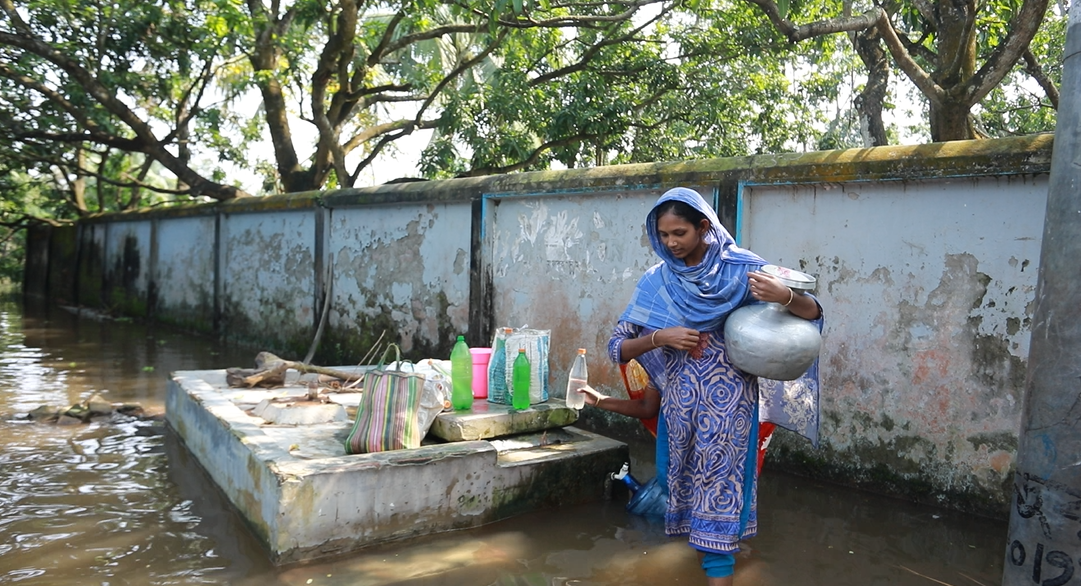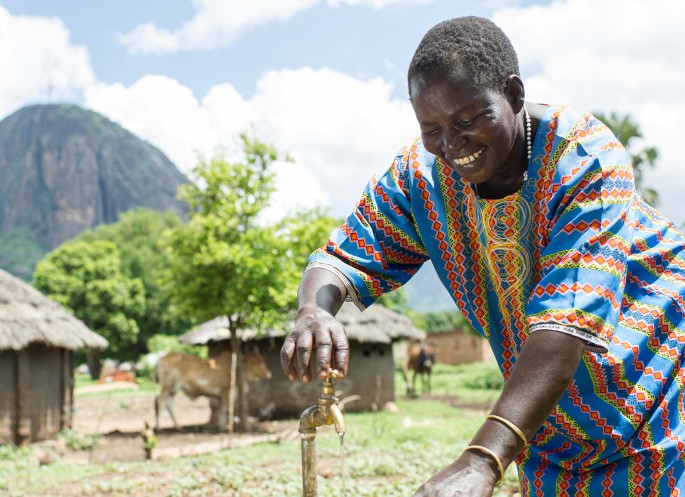How the Water Justice Fund puts women in charge of climate adaptation
Women bear the brunt of climate change, which is why they must be at the forefront of adaptation efforts. The Water Justice Fund is one of the first initiatives to channel climate adaptation funding directly into the hands of women. 'Locally led adaptation does not mean communities work in isolation. They get input from elsewhere—but they lead the process themselves.'
The story of Khorerdanga
Last year, two women’s groups representing fifty households in the village of Khorerdanga, located in the coastal region of Southern Bangladesh, came together to tackle a pressing issue. Their community lives on reclaimed land protected by polders, but these polders were flooding because the drainage canals had become clogged with sediment from the tidal rivers they feed into.
‘The women organised themselves and made this issue a priority. They wrote a proposal on their own and successfully persuaded the local Water Development Board to contribute sixteen thousand euros for canal excavation,’ says Hassan Rafath of the grassroots social development organisation Uttaran, which works closely with communities living on poldered land. The women not only contributed funds themselves but also took part in the physical labour of digging out the canal. ‘The local government was surprised by their capacity—the work was completed in just five days,’ he notes. Their efforts resolved the waterlogging problem for at least a few years, allowing them to reclaim land for gardens and cattle grazing. They are now working toward a more permanent solution.

Focus on empowering women
Rafath says this canal excavation is a clear example of what the Water Justice Fund, a partner of Uttaran, makes possible. The fund supports community-led, women-driven solutions to climate challenges. By putting women—who experience these impacts first-hand—in charge, it ensures that adaptation strategies are both effective and grounded in local realities.
'Bangladesh is a patriarchal society. In the communities where we work, women have traditionally been dominated by their husbands, fathers, and brothers. But through the Water Justice Fund, women have been able to organise themselves.'
This focus on women is essential, Rafath explains, because they play a central role in managing water within their households and communities. From fetching drinking water to using it for cooking, cleaning, and agriculture. As a result, they have a unique understanding of local water resources—how scarce or polluted they are, and what is needed to protect them.
The Water Justice Fund's strategy
Launched in 2023 by development organisation Simavi in partnership with three local organisations in Bangladesh, Nepal, and Kenya, the Water Justice Fund has already supported over seventy women-led grassroots initiatives focused on water justice. The long-term goal is for the Fund to operate independently from Simavi by 2030.
At the heart of the Water Justice Fund's approach are locally led adaptation and participatory grant-making. Women’s groups identify the most pressing water-related challenges in their communities, decide how to address them, and submit proposals to secure funding. But how can we ensure that everyone’s voice is heard? ‘When we enter a village, we do not speak with individuals—we engage the entire community,’ says Rafath.
The Water Justice Fund facilitates a process where all community members come together to share ideas, discuss priorities, and learn from one another to decide on the best solution. ‘There are groups of elders, lower caste members, women, and men—all are invited and heard. But within the Water Justice Fund, we intentionally prioritise women,’ he explains.
The process in detail
Women’s groups begin by discussing their needs and voting on a list of priorities. ‘Then they design a solution themselves—sometimes with our help and facilitation,’ Rafath says. ‘We also support them in writing and typing up proposals to apply for funding.’ These proposals are then reviewed by a peer group comprising local teachers, lawyers, journalists, NGO leaders, and women from civil society. Although they know the community well, they are independent, work voluntarily, and bring an outside perspective. The peer group visits the women’s groups to hear more about their priorities. Together, they decide which projects receive support from the Water Justice Fund.
The selected projects can address a wide range of water-related and climate adaptation needs—from flood protection and safe drinking water access to improved sanitation, toilets, tube wells, or water storage tanks. Once approved, the women lead the implementation of the projects and take responsibility for ongoing maintenance.

Our goal is to strengthen the women’s capacity—to help them write proposals and improve their advocacy skills.
Local and sustainable impact
The groups receive support and facilitation from partner organisations within the Water Justice Fund, such as Uttaran in Bangladesh. These organisations provide training, technical guidance, networking opportunities, and advocacy support. Rafath, who works with Uttaran, emphasises that their role is not to influence the women’s decisions. ‘We are simply facilitators,’ he explains.
Uttaran’s focus on capacity building is what makes the approach sustainable, Rafath explains. ‘It empowers them to draft and submit proposals to local government independently. They learn how to present their case and negotiate effectively. This gives communities the confidence to approach ward councillors and request services they are entitled to—such as tube wells or improved sanitation.’
According to Rafath, the impact of these skills extends beyond individual communities because they get to learn from each other. ‘The benefits of locally led adaptation are clear,’ he clarifies. ‘From the very beginning, it is the community that identifies and develops the intervention.
'If their top priority is access to drinking water, for instance, they might decide to excavate a pond themselves. Because the idea is theirs, they feel ownership—and that makes them more committed to maintaining it.'
This approach stands in contrast to top-down interventions imposed by organisations based in Dhaka. ‘When decisions are made far from the community, it is likely the solution will not fit,’ he explains. ‘They might suggest a livelihood activity that simply is not practised locally.’
A grassroots approach
Decision-making around climate adaptation and resilience is shifting from national and international NGOs to the most local level possible, says Vanita Suneja, Programme Lead of the Water Justice Fund. She leads the Fund’s secretariat, which coordinates participatory grant-making, fundraising, monitoring, evaluation, accountability, and learning.
‘The main advantage of this approach,’ says Suneja, ‘is that it truly aligns with the actual needs of women on the ground. It values traditional and indigenous knowledge alongside technical standards for climate-resilient water solutions.’ Unlike conventional programmes with rigid, pre-set goals, the Water Justice Fund offers flexibility to respond to emerging issues that require immediate action. While outcomes will vary depending on the local context—since the ideas originate from the women themselves—Suneja highlights that the strength lies in the process.
Moutushi Sengupta, who serves on the advisory board, explains how the approach ‘creates a space for women to come together and engage with other development challenges—a unit where people can learn and build trust. The power of the group is far greater than that of the individual.’

The great benefit of the locally led adaptation approach used by the Water Justice Fund is that it delivers context-specific solutions.
The fund as a catalyst
Suneja also explained that 'the way grassroots women’s groups come together to discuss, prioritise, design, and implement solutions is a robust model. It can be adapted and applied across different communities.'
The Fund acts as a catalyst, she explains. In many cases, financing for interventions does not come solely from the Water Justice Fund—local governments also contribute, while the women often invest through money or labour. In Nepal, for example, local governments co-finance up to fifty percent of community-led projects. In Bangladesh, government subsidies are common, with community members also contributing financially. In Kenya, communities frequently contribute in kind or through volunteer labour.
A balanced mix of knowledge
Still, communities do not develop solutions in isolation, Suneja points out. ‘Decision-making is locally led, but that does not mean outside knowledge is excluded. Communities learn from each other.’ Facilitating NGOs or community-based organisations also plays an important role by offering technical guidance and ensuring quality standards are met. ‘It is a balanced mix of scientific expertise and indigenous knowledge,’ Suneja explains. ‘There is interaction and exchange, but the community remains in control. Just because someone introduces a new technology does not mean the community loses its right to decide.’
For many participants, this approach is entirely new. ‘They are given responsibility for decision-making and managing budgets—often for the first time,’ she explains. ‘Forming committees, procuring materials, and being accountable for expenditures are all unfamiliar tasks.’The readiness of women’s groups varies, she notes, depending on their existing experience and capacity. ‘But what we consistently see is that once they take on these responsibilities, they grow in confidence. They are proud of what they have achieved and eager to share their successes.’
Suneja offers an example from a village in Nepal, where a pipeline extension was needed to improve water access. The women, who had previously relied on hand pumps and were not used to paying for water delivery, were initially hesitant to invest in the new system. ‘But through the process, they came to understand that piped water would offer better quality. They also learned how to submit a funding proposal to both the Water Justice Fund and the local government.’ Today, they are proud to have secured access to cleaner drinking water.

We need to show how locally led adaptation can actually work on the ground. And for that, the voices of grassroots women must be heard.
True autonomy for women
While the locally led adaptation model may seem new to many communities, NGOs, and donors, it is not built from scratch, Suneja stresses. ‘We build on decades of participatory approaches.’What sets the Water Justice Fund apart from earlier approaches, Suneja explains, is that the power to choose interventions truly rests with the community. ‘This time, the money goes directly into their hands. They handle procurement and project management. They are in control.’
This level of autonomy is still unfamiliar territory for many donors and NGOs in the development sector, Suneja adds. ‘It is time to think differently—even for international donors—and reflect on how locally led their efforts truly are. ‘Are they aligning their resources with the aspirations of the people they aim to support?’
Moutushi Sengupta emphasised the need for 'donors who do not demand solutions or results within just one year, but who trust the process—knowing that whatever the outcome, it will benefit the community more than a top-down approach.'
The power of lived stories
Sharing these lived experiences, Suneja explains, not only helps raise awareness among donors and other communities, but it also deepens understanding of the model itself. ‘It is essential to learn from the group processes—how leadership emerges, how negotiations with local government unfold, how conflicts are managed, and how cohesion is maintained. These are the stories that deserve greater attention.’
According to Rafath in Bangladesh, knowledge is the key. He recalls the words of a woman from a small village in the coastal south of the country: ‘In the past, we were given money or interventions designed by others. But we did not know how to use that money or make sense of the intervention. Now we do. We have learned how to negotiate with the local government chairperson and ask for what we need. When he comes to see us, I step out of my house with confidence. That is the change this has brought.’


